QThe mosques of Istanbul are considered the first destination for tourists in Turkey due to their ancient history, the stories of their construction, and the beauty of their design, which is characterized by the abundance of their domes.
The city of Istanbul (formerly Constantinople) is the central city throughout Turkey’s ancient and modern history, so it was natural for it to include a number of the most important tourist attractions in Turkey, on top of which are the historical mosques, some of which date back to the era of the Ottoman Caliphate and perhaps to the Roman and Byzantine eras as well, as both of them left a number Quite a few ancient churches that were converted into mosques coinciding with the Ottoman conquest of Constantinople.
The mosques of Istanbul have a unique architectural style, exquisite interior designs, and eye-catching colorful decorations that make them one of the most important tourist places in Istanbul that are recommended to be visited when traveling and wandering around the city.
During the article, we review with you the Istanbul guide to the most important and beautiful mosques in Istanbul, the most famous, popular, and visited by locals and tourists alike.
1- Sultan Ahmed Mosque
It is the largest mosque in Turkey built in the Ottoman style since the early 17th century, and it is the most famous tourist attraction in Istanbul as well, although it is famous among the locals and perhaps tourists as well as the “Blue Mosque” due to its soft blue tiles that cover its floors that extend to vast areas of tens of thousands of squares. meters.
The mosque is also famous for its multi-layered domes and the multiplicity of its minarets, which number up to 6 tall minarets.
The Sultan Ahmed Mosque is distinguished by being only meters away from the Hagia Sophia Museum and one of the most important tourist attractions in Istanbul. By visiting it, you will be in the process of visiting many of the most beautiful landmarks of Istanbul.
Sultan Ahmed Mosque is open to worshipers, and it is often crowded during prayer times. Therefore, if you are planning to go to him just for a visit, it is preferable to choose the dates that are far from the times of the prayer. It is preferable to go to him in the period a few hours before the noon prayer.
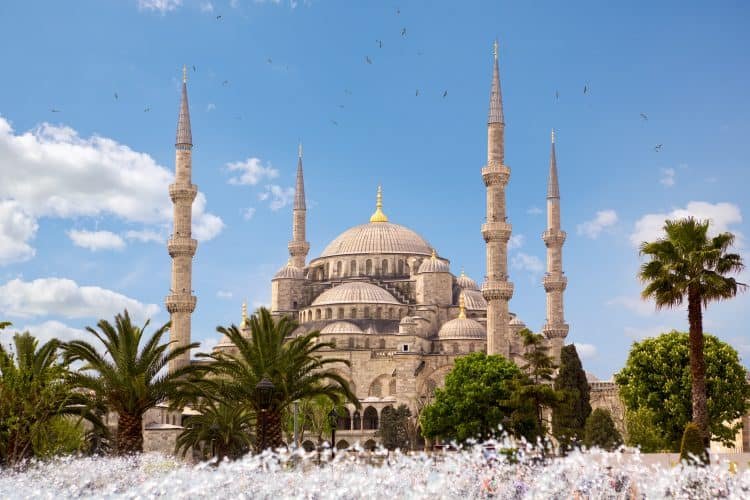
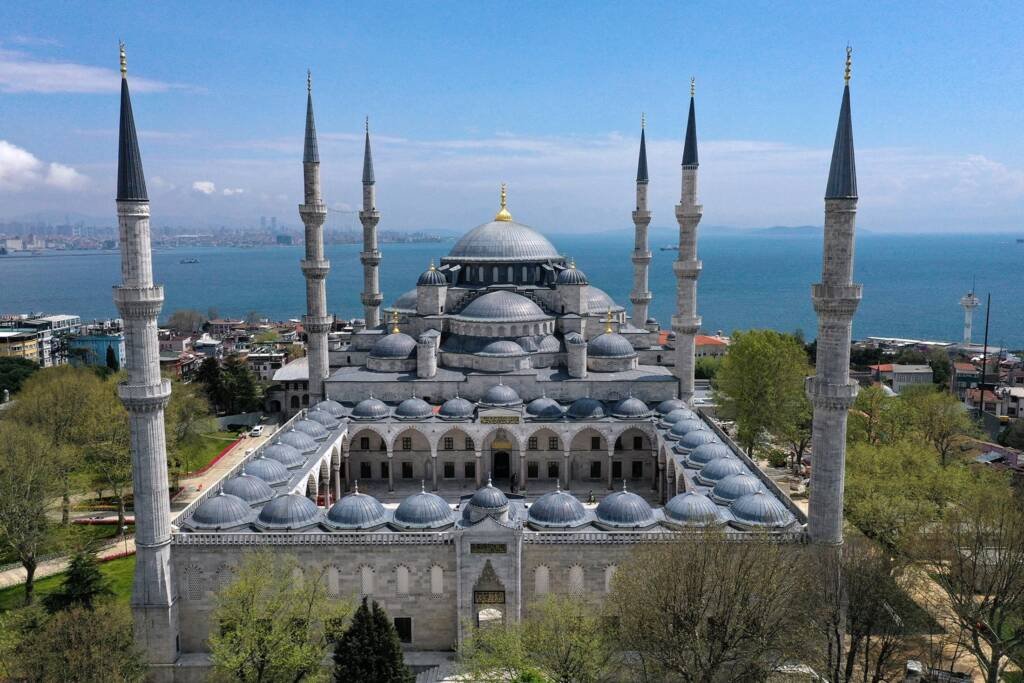
It is worth noting that Sultan Ahmed ordered the construction of the mosque during a difficult period that the Ottoman Empire went through, due to its loss in some wars. It was also built from the state treasury and not from the money of war spoils, and for this reason, the Sultan was criticized for its construction by some religious scholars.
The interior section of the Sultan Ahmed Mosque contains 260 windows of stained glass, and it is also lit by many valuable chandeliers coated with gold, precious stones and crystals.
Its interior walls are covered with more than 20,000 hand-carved blue ceramic pieces, all of which were brought from the cities of Iznik and Kütahya in more than 50 designs bearing different inscriptions.
And the desire of Sultan Ahmed to make his mosque the greatest and largest in the Ottoman Sultanate, he made it overlooking the Bosphorus Strait, opposite the Hagia Sophia Museum, and completed its construction only one year before his death, so that his body would be buried in the mosque.
The Sultan Ahmed Mosque is the only mosque in Turkey that includes 6 minarets in Ottoman architecture.
2- Süleymaniye Mosque
Creative approach to every project
The Suleymaniye Mosque is one of the most famous and largest ancient mosques in Istanbul built in the 16th century, which a tourist cannot miss during a tourism tour in Turkey and his visit to the charming tourist city of Istanbul.
The mosque is distinguished by its magnificent and unique architectural style. The mosque was designed by Mimar Sinan, “the most famous Ottoman architect,” and he also contributed to the expansion of the Grand Mosque in the 16th century.
The Sulaymaniyah Mosque was built in the period 1550-1557 AD, during the reign of Sultan Suleiman the Magnificent, after whom it was named, by the famous architect “Sinan” in the style of classical Ottoman architecture.
The Suleymaniye Mosque contains four minarets, and the reason for its being four is that Sultan Suleiman the Magnificent’s fourth ranking among the sultans of the Ottoman Empire after the conquest of Istanbul, The minarets have 10 honours, indicating the rank of Sultan Suleiman X among the sultans of the Ottoman Empire.
As for the diameter of the large dome of the mosque, it is 26.5 meters, and its height is 53 meters. On it are columns that were brought from different places, one from the Beqaa Temple in the Bekaa Valley in Lebanon, one from the city of Alexandria in Egypt, and the rest from the Topkapi Palace and the Al-Wafaa neighborhood in Istanbul.

The Suleymaniye Mosque is located on a hill overlooking the Gulf and the Bosphorus Strait. The mosque contains the tomb of Sultan Suleiman, his sanctuary, and the tomb of the architect Sinan.
The outer courtyard of the mosque is surrounded by a low stone fence, and from this fence you can overlook the most beautiful views of Istanbul, where the strait and the bay are.
3- Eyüp Sultan Mosque
This mosque is located on the coast of the Golden Horn Bay, branching from the Bosphorus Strait. It is known in Turkey as “Eyup Sultan”.
It is the mosque of the great companion Abu Ayyub al-Ansari. The Abu Ayyub Al-Ansari Mosque dates back to the era of the conquest of Istanbul. Seventh AD.
Abu Ayyub al-Ansari was nearly eighty years old when he participated in the Roman war under the leadership of Yazid bin Muawiyah during the reign of Muawiya bin Abi Sufyan. Byzantium Despite the long siege of the Umayyads, the shrine of Abu Ayyub al-Ansari found great appreciation among the Byzantines and their kings.
In the summer of 1453 AD, the Ottoman Sultan Mehmed II – or Mehmed the Conqueror as he was known later – managed to conquer Constantinople, ending the Byzantine era that lasted for more than 11 centuries, and finding the tomb of Abu Ayyub al-Ansari was one of the first symbols of that conquest.
The Ottoman Sultan asked his men to determine the burial place of the Companion, and after they found the tomb of Abu Ayyub al-Ansari, the Sultan immediately requested that the mosque be built and several sections attached to it. Those sections were in their time a large religious, educational and social complex, and the mosque also included a restaurant for the poor and a bathroom Turkey, architecture flourished around it and trade was active. This mosque is considered the fourth sacred Islamic place for the Turks, coming in its place after Mecca, Medina and Jerusalem. Although Istanbul is the undisputed capital of mosques, a large number of worshipers flock to the Abu Ayyub al-Ansari Mosque, especially on Fridays, to perform prayers.

The mosque is considered the fourth sacred Islamic place for the Turks, coming in its place after Mecca, Medina and Jerusalem. Although Istanbul is the undisputed capital of mosques, a large number of worshipers flock to the Abu Ayyub al-Ansari Mosque, especially on Fridays, to perform prayers.
In the first courtyard of the mosque, there are several marble fountains attached to the wall, adorned with Islamic and Roman inscriptions as well, and not far from it, there are places for ablution for men.
In the second square, where the crowds are intense, the place on its right side leads to the great prayer hall, and on the other hand, visitors line up to enter the tomb of Abu Ayyub al-Ansari.
In the middle of the inner courtyard of the mosque, adjacent to the building that houses the shrine, is a rectangular yard surrounded by an iron fence. There is a giant ancient tree inside the square, which is believed to have existed since the death of Abu Ayyub, and on every corner of the fence there is a salsabil from which visitors drink. Blessed water. This is how we notice the frequent frequency of single girls throughout the week to this mosque, asking God to facilitate their marriage soon. There are young boys who are preparing for the circumcision process, accompanying their parents here to be blessed, and some parents come to pray for their children to succeed in studies, in life, in finding a job opportunity, and so on. Also, the owner of this place is innocent of what may happen of heresy.
4- Ortakoy Mosque
The Ortakoy Mosque is considered one of a series of historical establishments that adorn the Bosphorus Strait region. It is also known as the Buyuk Majidiye Mosque. It was ordered to be built by Sultan Abdul Majeed and designed by the architect Nikoğos Balyan, who studied architecture in France. The mosque was opened for worship for the first time in 1854 AD.
The Ortakoy Mosque is one of the most important symbols of the city of Istanbul, as it is distinguished by its beautiful architecture, which is dominated by the Baroque style, which is a special urban style that was commonly used in the palaces of Europe in the seventeenth century.
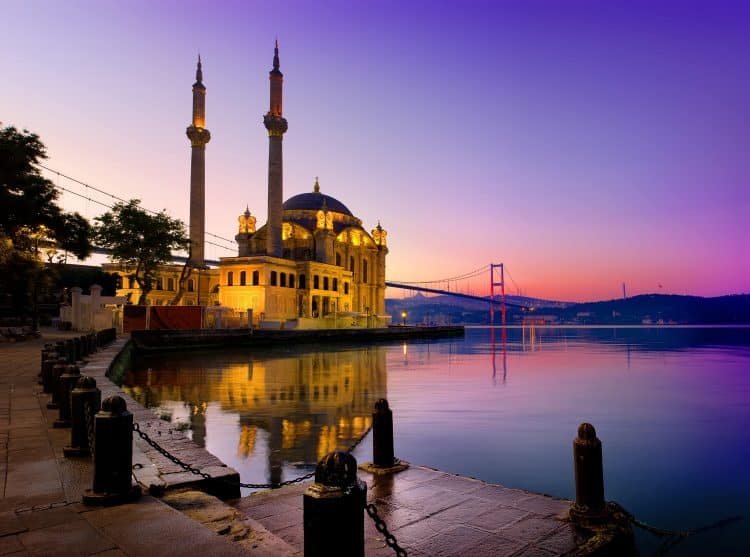
One of the most beautiful and luxurious mosques in Istanbul, distinguished by its charming view of the Bosphorus and its graceful towering minarets with arched walls decorated with attractive Baroque carvings.
Then you can wander around the corners and alleys of the small Ortakoy district, one of the tourist areas in Istanbul that is famous for its ancient history dating back to the 18th century, where shops and stalls are crowded during the day and bars and restaurants are upscale and noisy at night, which usually attract young people and the city’s wealthy.
What makes Ortakoy, with its monuments and bustling nightlife, one of the most important areas that you should put on your visit list during Istanbul tourism tours.
5- Rüstem Pasha Mosque
The history of the Rustem Pasha Mosque, which is located in the old and crowded market area in the Eminonu region, dates back between 1561 and 1563. The mosque was built to bear the name of the Great Vizier of Croatian origin, Rustem Pasha, who was the husband of the daughter of Sultan Suleiman the Magnificent, Sultan Mihrimah, by the hand of the engineer Architect Sinan Agha, the famous imperial architect, who also built a number of famous Ottoman mosques.
The Rustem Pasha Mosque is famous for being covered with beautiful decorative pieces that are unique examples of the art of the Ottoman court, and distinctive ceramic pieces originating from Turkish Iznik, which was an important source in the production of ceramics at that time, as this Iznik covers the entire walls and the areas of the mihrab and the door as well, and there is no other mosque In Istanbul, it contains this amount of this famous ceramic, and perhaps what increases the magnificence of the mosque is that it contains a large number of red ceramics, which were rare at that time due to the difficulty of producing them.
It is worth noting that the “Iznik porcelain” used in the interior designs of the historic mosque attracts the attention of foreign and Turkish visitors, clearly, standing in front of it and looking at it with watches, and taking memorial photos of it.
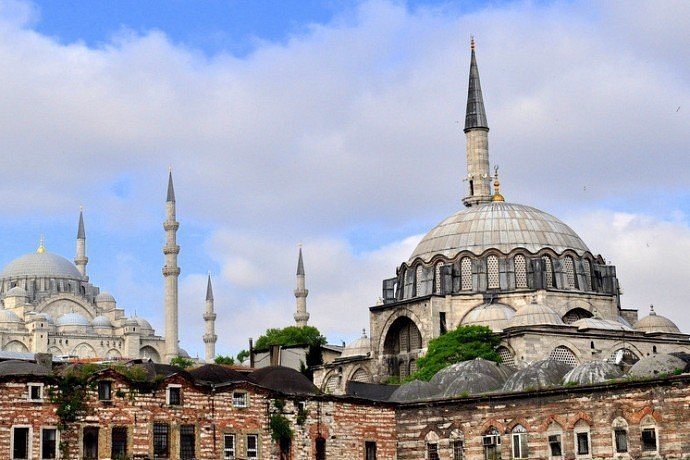
When you look at Eminonu from the opposite side of the Golden Horn Bay, or from one of the ships passing through the Gulf, you will encounter this wonderful scene. At sea level, you will see the Rustem Pasha Mosque, which was built on a raised terrace above a complex of shops whose rent is allocated to support the mosque financially. Behind it is the Suleymaniye Mosque, which overlooks the scene, so that the minarets and domes of those mosques form a wonderful painting that sums up the history and future of the city of Istanbul.
6- Sultan Muhammad Al-Fatih Mosque
The Al-Fateh Mosque, one of the most important and largest mosques in Istanbul, is gaining importance because it is located in the heart of its neighborhoods inside the old city, on a hill in the Al-Fateh area, and it is one of the oldest large mosques, which Sultan Mehmed Al-Fateh ordered to be built, and the mosque embraces the Al-Fateh shrine as well.
The mosque is considered, at the present time, one of the most important Islamic destinations in the region, as it is located in the heart of a residential neighborhood, in which Turkish Muslims and other residents and visitors of Turkey mix, to be crowded at different times of the day.
Sultan Muhammad al-Fatih issued his order to build the al-Fatih Mosque and chose a place for it in the heart of Constantinople, on the ruins of the ancient Church of the Apostles.
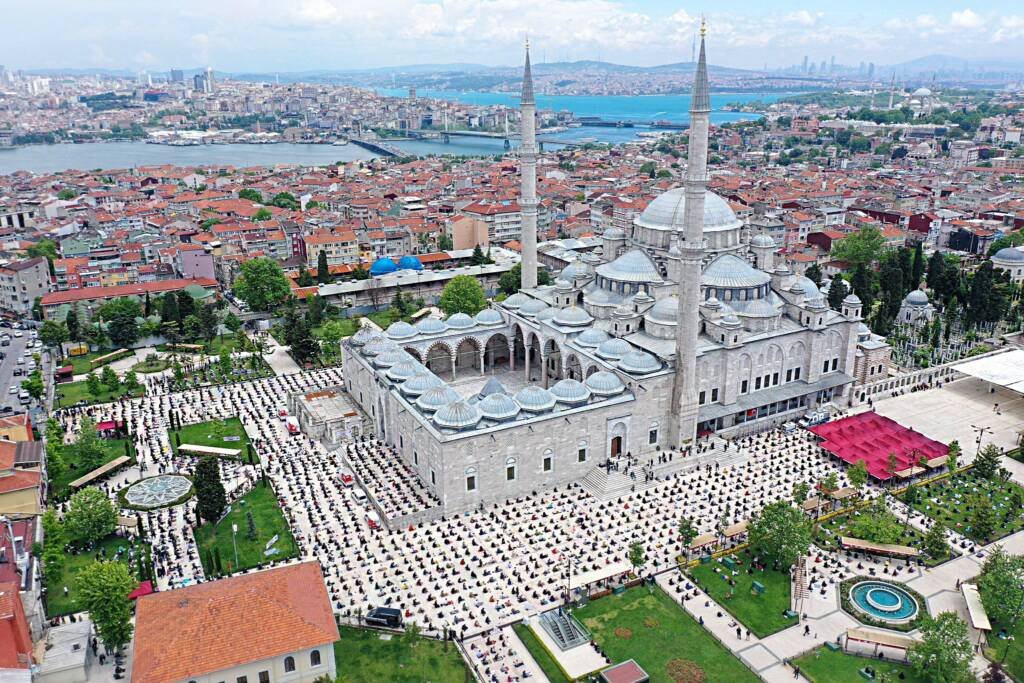
The mosque was established between 1463 AD – 1470 AD, and the Al-Fateh Mosque was part of the largest university established in Istanbul, as the university includes, in addition to the mosque, sixteen colleges with Dar Al-Shifa, a guest house, and a library, all located within what is known today as the Fatih district in Istanbul.It is considered Al-Fatih Mosque is one of the most beautiful archaeological and religious sites in Istanbul, but the building that we see today is not identical to the image on which it was built, and the reason is due to the massive earthquake that struck Istanbul in 1766 AD.
The earthquake led to its almost complete destruction, so it was rebuilt by the architect Muhammad Tahir Agha by order of Sultan Mustafa III in 1767 AD, as it was built completely differently from what it was, and the only thing that remained of the old mosque was the inner courtyard surrounded by a gallery covered with 22 domes supported by 18 columns.
The sundial engraved on the stone is considered one of the most important monuments that attract attention in the Al-Fateh Mosque, and it was engraved on the minaret of the mosque from the direction of Fawzi Pasha Street, and it is considered one of the most beautiful models of the sundial in history.
The Al-Fateh Mosque is also distinguished by the presence of a water well inside it, and it is now present in the form of a water pathway within the mosque, and next to the main courtyard door of the mosque there is a tank for extinguishing water and it is surrounded by a wall and an iron grille, and this tank was used during the Ottoman era, and it was established in 1825 AD by the Sultan Mahmoud II.
7- Shahzad Mosque (Emir Mosque)
The Ottoman Sultan Suleiman the Magnificent ordered the construction of the Scheherazade Mosque as a memorial to his favorite son, Shehzade Mehmed(born 1521), who died in 1543 while returning to Istanbul after a victorious military campaign in Hungary.
Mehmed was the eldest son of Suleiman’s only legal wife, Sultan Hürrem Sultan – although he was not his eldest son – and before his untimely death he was preparing to accept the Sultanate after Suleiman’s reign. It is said that Suleiman personally mourned Mehmed’s death for forty days in his makeshift tomb in Istanbul, where the imperial architect Mimar Sinan built a lavish mausoleum for Mehmed as part of a mosque dedicated to the crown prince. The mosque was the first of the famous architect Sinan’s important imperial monuments and one of his most ambitious architectural works, although it was designed early in his long career.
This elegant mosque is one of the three most beautiful mosques in Istanbul. The mosque is surrounded by a courtyard with colonnaded arcades. The area of the square is approximately equal to the area of the mosque. Columns define it on the borders of the square. There are also five rooms with domes in each of the facades of the square. These rooms have marble arches striped in white and pink.

In the center there is a ritual ablution that was donated by Sultan Murad IV to the mosque some time after its construction. The mosque has two minarets, which are carved in a very precise and exquisite geometric way. The plan of the mosque is square in shape, in its center is a central dome surrounded by four half-domes, and the dome is supported by four walls, with a diameter of 19 meters and a height of 37 meters.
The mosque from the inside is symmetrical on both sides, and the area under the dome is wide due to the use of four semi-domes next to the central dome, each one on one side, in a form resembling the four leaves of plants. However, this method of construction was not entirely successful, because it separates the four large walls that support the central dome from each other, and Sinan Agha did not use this method again. The mosque from the inside is simple in installation and does not contain any corridors or corridors.
8- The New Mosque
The Mosque of the Sultan’s Mother, or it is also called in the Turkish language “Yeni Mosque”, which means the new mosque.
It was built by order of Sultana “Safiyya” from the wife of the Ottoman Sultan “Murad III”, to be one of the most important monuments of the city of Istanbul.
The mosque derives its fame mainly from its dominant location on the waterfront of the Galata Bridge in the Fatih district, located at the entrance to the Egyptian market or the spice market in Istanbul.
The new mosque is distinguished by its exquisite architecture and stunning interior design that combines meticulously tiled floors with the liberal use of gold paint.
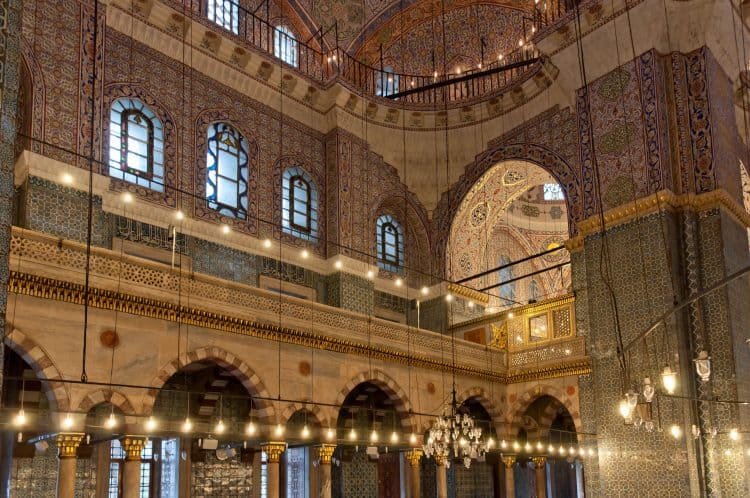
9- Çamlıca Mosque, the largest in Türkiye
The construction of the mosque, which is located on the highest peak in the city of Istanbul, in the style of Ottoman architecture, began in 2013, and it was officially opened in 2019.
The mosque is built on an area of 15,000 square meters, and can accommodate about 50,000 worshipers. It includes a conference hall, a museum of Turkish Islamic antiquities, a public library, and an art gallery.

The mosque is topped by 6 minarets, 4 of which are 107.1 meters long, and two are 90 meters long, while its dome is about 72 meters high and 34 meters in diameter.
Gardens have been allocated around the mosque with an area of 30 dunums, so that visitors can take a walk in it and enjoy the view of its view, which is considered one of the most beautiful views of Istanbul.
The gardens overlook the Asian and European parts of the city, as well as part of the Marmara Sea.
The mosque was built at the top of a hill in the Uskudar region (on the Asian side of the city), to be one of the most visible landmarks on the city’s skyline.
Did you visit a mosque in Istanbul during your trip to Türkiye? Do not forget to interact with us in the comments and share your experience with us and our valued readers! If you liked the article, share it with your friends.



